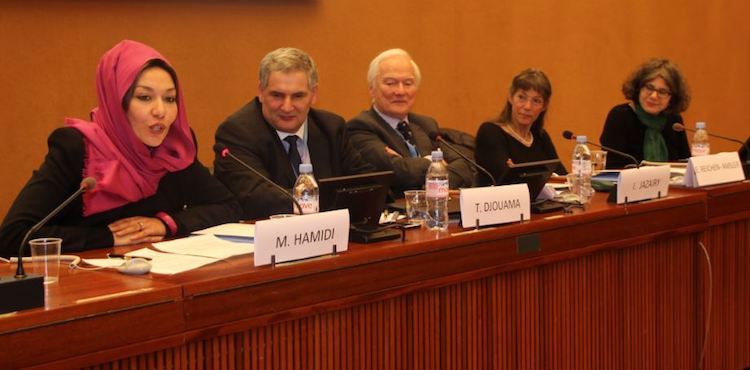By Jaya Ramachandran
GENEVA (IDN) – The headscarf that sparks heated debates in Europe is a source of commonality between the three main Abrahamic religions Islam, Christianity and Judaism, according to experts who participated in a debate at the United Nations office in Geneva.
The event on February 23 focused on: Veiling/Unveiling: The Headscarf in Christianity, Islam and Judaism. The Geneva Centre for Human Rights Advancement and Global Dialogue (Geneva Centre) and the Permanent Mission of Algeria to the UN in Geneva organized the discussion in the run-up to the 37th regular session of the UN Human Rights Council scheduled for February 26 to March 23, 2018. JAPANESE | CHINESE
The Geneva Centre’s Executive Director Ambassador Idriss Jazairy who moderated the event – accompanied by an exhibition related to the theme – said it was intended to address stereotypical views on the use of the veil and “reveal the headscarf as a connecting thread and “an element of convergence” in Christianity, Islam and Judaism.”
He added: “The headscarf represents commonality, rather than discord; it should connect and build bridges between cultures, rather than divide. It has played an important role in defining identities in all three Abrahamic religions.”
The use of the so-called ‘veil’ must not become the subject of politicization and deny women their personal freedom of choice regarding the use of the headscarf. He said that “denying women their right to wear or not to wear the headscarf” violates Article 18 of the Universal Declaration on Human Rights.
“Imposing it on women or prohibiting it by law represent a violation of their basic rights. The only way to defend women’s rights and to promote the advancement of their status is to respect their right to choose,” said the Geneva Centre’s Executive Director.
The Deputy Permanent Representative of Algeria, Toufik Djouama, said numerous groups that believe in the “clash of civilizations” are cultivating a “degrading image about the Islamic headscarf.” The use of the veil, he said, is “a personal choice” taken by Muslim women.
Djouama observed that promoting “dialogue, mutual understanding, respect of human rights and diversity” must remain key priorities for governments, civil society organizations and academia. The freedom to manifest one’s religion or belief in public as stipulated in Article 18 of the Universal Declaration on Human Rights must allow women to decide themselves whether to wear or not to wear the headscarf, he said.
Elisabeth Reichen-Amsler, Director of Church and Society section within the Evangelical Reformed Church of the Neuchâtel Canton (EREN) remarked that the use of the headscarf couldn’t be considered as solely belonging to Islam as often stated in public discourse. In fact, its roots can be traced back to ancient cultures in Mesopotamia, Ancient Greece, the Roman Empire and the birth of Christianity. “The obligation for married women to wear the headscarf was already mentioned in an ancient law written in 1120 B.C. by an Assyrian king,” Reichen-Amsler said.
In the letter of Paul of Tarsus to the Corinthians in Genesis 2:21, she added, women were obliged to wear the headscarf. This obligation lasted for approximately 1900 years in Christianity. It was only during the 1960s that women were no longer obliged to wear the headscarf for religious purposes. This explains the different interpretations of Islam, Judaism and Christianity regarding the use of the headscarf.
Dr. Malika Hamidi, author of the book “Muslim feminism – why not?” highlighted that feminist and secular movements in France had objected to the wearing of Islamic headscarves by Muslim women as it allegedly violated the right to their liberty and dignity. However, numerous women in political and secular movements have maintained that there is “no contradiction between the headscarf and freedom” and “between the dignity and respectability of women.”
Feminist movements in French-speaking Europe, she said, remain “shaken” by the fact that some Muslim women hold the view that the headscarf has “liberated them in their relationship with men and European societies.” She added: “The fact that women are wearing headscarves, within the limits determined by Islam may allow them to gain more respect but represents a vector of social, political and cultural participation which is strongly questioned in the West.”
Dr. Valérie Rhein, an expert on theology holding a PhD in Judaism at the Institute of Jewish Studies, University of Bern, stated that the use of the headscarf is an ancient tradition of Judaism. It was a custom, she said, “for a Jewish bride to veil her face before the marriage ceremony”. This practice is mentioned in Genesis 24 of the Bible which describes the first encounter between Isaac and Rebekah.
She added that the Talmudic law, rooted in the concept of Zniut/Modesty, also required women to cover their hair after marriage as it symbolizes belonging to “observant Judaism” and of being married. It was also incumbent on men to wear a headgear (kippah) as it symbolises a “sign of respect” and a “relationship with God.” [IDN-InDepthNews – 23 February 2018]
Photo: Panel Debate about Veiling/Unveiling at UN Office in Geneva




